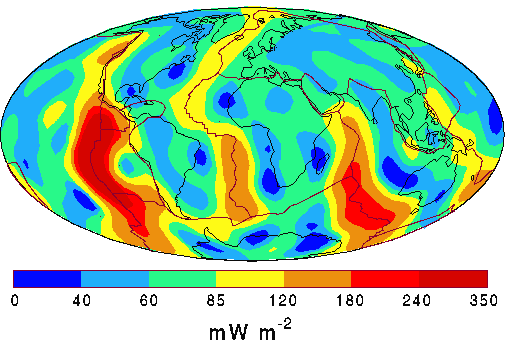Global Heat Flow Map

This map shows color-coded contours of the global distribution of heat flow at the surface of the Earth's crust. Major plate boundaries and continent outlines are also shown. The fundamental data embodied in this map are the more than 24,000 field measurements in both continental and oceanic terrains, supplemented by estimates of the heat flow in the unsurveyed regions. The estimates are based on empirically determined charactersitic values for the heat flux in various geological and tectonic settings. Observations of the oceanic heat flux have been corrected for heat loss by hydrothermal circulation through the oceanic crust. The global data set so assembled was then subjected to a spherical harmonic analysis. The map is a representation of the heat flow to spherical harmonic degree and order 12.
Estimates of the radiogenic contribution (from the decay of U, Th and K in the mantle) vary from 19 to 31 TW. Thus, there is either a good balance between current input and output, or there is a serious missing heat source problem, up to a deficit of 25 TW. Attempts to solve the perceived deficit problem include invoking secular cooling and deep, hidden heat-source layers.
In many studies it has been assumed that there should be a steady-state balance, or close to it, between current radioactive heat production in the mantle and current heat flow, and that very little heat is generated in the upper mantle. This view ignores mass balance considerations, other sources of energy, secular cooling, delays in the system, and the wide range of radioactive contents of upper mantle materials. These problems can be avoided by recognizing that:
- heat flow is a three-dimensional problem and that heat flow is diverted into the ocean basins;
continents tend to move towards cold downwelling mantle;
- at high mantle temperatures water is removed from both the mantle and the lithosphere, stiffening the system;
- the mantle is probably chemically layered, extending the cooling time, and
the upper mantle cannot be entirely composed of ultradepleted MORB and barren peridotite.
The movement of heat within the Earth and its eventual loss through the surface are central elements in the modern theory of plate tectonics. The plate movements over the surface of the Earth are seen as one manifestation of a heat engine at work in the interior, and the heat flow at the surface as the exhaust from the engine.

